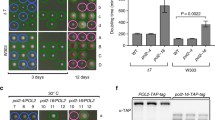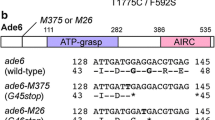Summary
Mutations in the SPT4 gene of Saccharomyces cerevisiae were isolated as suppressors of δ insertion mutations that interfere with adjacent gene transcription. Recent genetic evidence indicates that the SPT4 protein functions with two other proteins, SPT5 and SPT6, in some aspect of transcription initiation. In this work we have characterized the SPT4 gene and we demonstrate that spt4 mutations, like spt5 and spt6 mutations, cause changes in transcription. Using the cloned SPT4 gene, spt4 null mutations were constructed; in contrast to spt5 and spt6 null mutants, which are inviable, spt4 null mutants are viable and have an Spt− phenotype. The DNA sequence of the SPT4 gene predicts a protein product of 102 amino acids that contains four cysteine residues positioned similarly to those of zinc binding proteins. Mutational analysis suggests that at least some of these cysteines are essential for SPT4 function. Genetic mapping showed that SPT4 is a previously unidentified gene that maps to chromosome VII, between ADE6 and CLY8.
Similar content being viewed by others
References
Altschul SF, Gish W, Miller W, Myers EW, Lipman DJ (1990) Basic local alignment search tool. J Mol Biol 215:403–410
Berg JM (1986) Potential metal binding domains in nucleic acid binding proteins. Science 232:485–487
Berg JM (1990) Zinc fingers and other metal binding domains. J Biol Chem 265:6513–6516
Birnboim HC, Doly J (1979) A rapid alkaline extraction procedure or screening recombinant plasmid DNA. Nucleic Acids Res 7:1513–1523
Botstein D, Falco SC, Stewart SE, Brennan M, Scherer S, Stinchcomb DT, Struhl K, Davis RW (1979) Sterile host yeasts (SHY): A eukaryotic system of biological containment for recombinant DNA experiments. Gene 8:17–24
Boyer HW, Roulland-Dussoix D (1969) A complementation analysis of the restriction and modification of DNA in E. coli. J Mol Biol 41:458–472
Carlson M, Botstein D (1982) Two differentially regulated mRNAs with different 5′ ends encode secreted and intracellular forms of yeast invertase. Cell 28:145–154
Celenza JL, Carlson M (1986) A yeast gene that is essential for release from glucose repression encodes a protein kinase. Science 233:1175–1180
Chaleff DT, Fink GR (1980) Genetic events associated with an insertion mutation in yeast. Cell 21:227–237
Clark-Adams CD, Norris D, Osley MA, Fassler JS, Winston F (1988) Changes in historic gene dosage alter transcription in yeast. Genes Dev 2:150–159
Clark-Adams CD, Winston F (1987) The SPT6 gene is essential for growth and is required for δ-mediated transcription in Saccharomyces cerevisiae. Mol Cell Biol 7:679–686
Eisenmann DM, Dollard C, Winston F (1989) SPT15, the gene encoding the yeast TATA binding protein TFIID, is required for normal transcription initiation in vivo. Cell 58:1183–1191
Eisenmann DM, Arndt KM, Ricupero SL, Rooney JW, and Winston F (1992) SPT3 interacts with TFIID to allow normal transcription in Saccharomyces cerevisiae. Genes Dev 6:1319–1331
Elder RT, Loh EY, Davis RW (1983) RNA from the yeast transposable element Tyl has both ends in the direct repeats, a structure similar to retrovirus RNA. Proc Natl Acad Sci USA 80:2432–2436
Falco SC, Botstein D (1983) A rapid chromosome-mapping method for cloned fragments of yeast DNA. Genetics 105:857–872
Falco SC, Li Y, Broach JR, Botstein D (1982) Genetic properties of chromosomally integrated 2 μ plasmid DNA in yeast. Cell 29:573–584
Farabaugh PJ, Fink GR (1980) Insertion of the eukaryotic transposable element Tyl creates a 5-base pair duplication. Nature 286:352–356
Fassler JS, WinstonZ F (1988) Isolation and analysis of a novel class of suppressor of Ty insertion mutations in Saccharomyces cerevisiae. Genetics 118:203–212
Fassler JS, Winston F (1989) The Saccharomyces cerevisiae SPT13/GAL11 gene has both positive and negative regulatory roles in transcription. Mol Cell Biol 9:5602–5609
Feinberg AP, Vogelstein B (1983) A tecnique for radiolabeling restriction endonuclease fragments to high specific activity. Anal Biochem 132:6–13
Field J, Nikawa J-I, Broek D, MacDonald B, Rodgers L, Wilson IA, Lerner RA, Wigler M (1988) Purification of a RAS-responsive adenylyl cyclase complex from Saccharomyces cerevisiae by use of an epitope addition method. Mol Cell Biol 8:2159–2165
Grunstein M (1990) Histone function in transcription. Annu Rev Cell Biol 6:643–678
Han M, Grunstein M (1988) Nucleosome loss activates downstream promoters in vivo. Cell 55:1137–1145
Happel AM, Swanson MS, Winston F (1991) The SNF2, SNF5, and SNF6 genes are required for Ty transcription in Saccharomyces cerevisiae. Genetics 128:69–77
Hard T, Kellenbach E, Boelens R, Maler BA, Dahlman K, Freedman LP, Carlstedt-Duke J, Yamamoto KR, Gustafsson J-A, Kaptein R (1990) Solution structure of the glucocorticoid receptor DNA-binding domain. Science 249:157–160
Hirschhorn JN, Brown SA, Clark CD, Winston F (1992) Evidence that SNF2/SWI2 and SNF5 activate transcription in yeast by altering chromatin structure. Genes Dev 6:2288–2298
Hirschhorn JN, Winston F (1988) SPT3 is required for normal levels of a-factor and α-factor expression in Saccharomyces cerevisiae. Mol Cell Biol 8:822–827
Hirschman JE, Durbin KJ, Winston F (1988) Genetic evidence for promoter competition in Saccharomyces cerevisiae. Mol Cell Biol 8:4608–4615
Hoffman CS, Winston F (1987) A ten-minute DNA preparation from yeast efficiently releases autonomous plasmids for transformation of Escherichia coli. Gene 57:267–272
Ito H, Fukuda Y, Murata K, Kimura, A (1983) Transformation of intact yeast cells treated with alkali cations. J Bacteriol 153:163–168
Johnston M, Davis RW (1984) Sequences that regulate the divergent GAL1-GAL10 promoter in Saccharomyces cerevisiae. Mol Cell Biol 4:1440–1448
Kayne PS, Kim U-J, Han M, Mullen JR, Yoshizaki F, Grunstein M (1988) Extremely conserved histone H4 N terminus is dispensable for growth but essential for repressing the silent mating type loci in yeast. Cell 55:27–39
Klapholz S, Esposito R (1982) A new mapping method employing a meiotic rec − mutant of yeast. Genetics 100:387–412
Kunkel TA, Roberts JD, Zabour RA (1987) Rapid and efficient site-specific mutagenesis without phenotypic selection. Methods Enzymol 154:367–382
Liao X-B, Clare JJ, Farabaugh PJ (1987) The upstream activation site of a Ty2 element of yeast is necessary but not sufficient to promote maximal transcription of the element. Proc Natl Acad Sci USA 84:8520–8524
Malone EA, Clark CD, Chiang A, Winston F (1991) Mutations in SPT16/CDC68 suppress cis − and trans-acting mutations that affect promoter function in Saccharomyces cerevisiae. Mol Cell Biol 11:5710–5717
Maniatis T, Fritsch EF, Sambrook J (1982) Molecular cloning: a laboratory manual. Cold Spring Harbor Laboratory, Cold Spring Harbor, New York
Megee PC, Morgan BA, Mittman BA, Smith MM (1990) Genetic analysis of histone H4: essential role of lysine subject to reversible acetylation. Science 247:841–845
Messing J (1979) A multipurpose cloning system based on the single-stranded DNA bacteriophage M13. Recombinant DNA Technical Bulletin (NIH Publication No. 79–99) 2:43–48
Mortimer RK, Schild D, Contopoulou CR, Kans JA (1989) Genetic map of Saccharomyces cerevisiae, Edition 10. Yeast 5:321–403
Natsoulis G, Dollard C, Winston F, Boeke JD (1991) The products of the SPT10 and SPT21 genes of Saccharomyces cerevisiae increase the amplitude of transcriptional regulation at a large number of unlinked loci. New Biologist 3:1249–1259
Neigeborn L, Celenza JL, Carlson M (1987) SSN20 is an essential gene with mutant alleles that suppress defects in SUC2 transcription in Saccharomyces cerevisiae. Mol Cell Biol 7:672–678
Niman HL, Houghton RA, Walker LE, Reisfeld RA, Wilson IA, Hogle JM, Lerner RA (1983) Generation of protein-reactive antibodies by short peptides is an event of high frequency: implications for the structural basis of immune recognition. Proc Natl Acad Sci USA 80:4949–4953
Norrander J, Kempe T, Messing J (1983) Construction of improved M13 vectors using oligodeoxynucleotide-directed mutagenesis. Gene 26:101–106
Oliver SG et al. (1992) The complete DNA sequence of yeast chromosome III. Nature 357:38–46
Orr-Weaver TL, Szostak JW, Rothstein RJ (1983) Genetic application of yeast transformation with linear and gapped plasmids. Methods Enzymol 101:228–245
Pan T, Freedman LP, Coleman JE (1990) Cadmium-113 NMR studies of the DNA binding domain of the mammalian glucocorticoid receptor. Biochemistry 29:9218–9225
Park E-C, Szostak JW (1990) Point mutations in the yeast histone H4 gene prevent silencing of the silent mating type locus HML. Mol Cell Biol 10:4932–4934
Pugh BF, Tjian R (1992) Diverse transcriptional functions of the multisubunit eukaryotic TFIID complex. J Biol Chem 267:679–682
Rigby PW, Dickman M, Rhodes C, Berg P (1977) Labeling deoxyribonucleic acid to high specific activity in vitro by nick translation with DNA polymerase I. J Mol Biol 113:237–251
Roeder GS, Fink GR (1980) DNA rearrangements associated with a transposable element in yeast. Cell 21:239–249
Rose MD, Novick P, Thomas JH, Botstein D, Fink GR (1987) A Saccharomyces cerevisiae genomic plasmid bank based on a centromere-containing shuttle vector. Gene 60:37–243
Rose MD, Winston F, Heiter P (1990) Methods in yeast genetics, revised edition. Cold Spring Harbor Laboratory, Cold Spring Harbor, New York
Rothstein R (1983) One-step gene disruption in yeast. Meth Enzymol 101:202–211
Rowley A, Singer RA, Johnston GC (1991) CDC68, a yeast gene that affects regulation of cell proliferation and transcription, encodes a protein with a highly acidic carboxyl terminus. Mol Cell Biol 11:5718–5726
Sanger F, Nicklen S, Coulson AR (1977) DNA sequencing with chain-terminating inhibitors. Proc Natl Acad Sci USA 74:5463–5467
Sawadogo M, Sentenac A (1990) RNA polymerase B (II) and general transcription factors. Annu Rev Biochem 59:711–754
Scherer S, Davis RW (1979) Replacement of chromosome segments with altered DNA sequences constructed in vitro. Proc Natl Acad Scie USA 76:4951–4955
Severne Y, Wieland S, Schaffner W, Rusconi S (1988) Metal binding ‘finger’ structures in the glucocorticoid receptor defined by site-specific mutagenesis. EMBO J 7:2503–2508
Silverman SJ, Fink GR (1984) Effects of Ty insertions on HIS4 transcription in Saccharomyces cerevisiae. Mol Cell Biol 4:1246–1251
Simchen G, Winston F, Styles CA, Fink GR (1984) Ty-mediated expression of the LYS2 and HIS4 genes of Saccharomyces cerevisiae is controlled by the same SPT genes. Proc Nall Acad Sci USA 81:2431–2434
Som T, Armstrong KA, Volkert FC, Broach JR (1988) Autoregulation of 2 μm circle gene expression provides a model for maintenance of stable plasmid copy levels. Cell 52:27–37
Southern EM (1975) Detection of specific sequences among DNA fragments separated by gel electrophoresis. J Mol Biol 98:503–517
Struhl K, Stinchcomb DT, Scherer S, Davis RW (1979) High frequency transformation of yeast: Autonomous replication of hybrid molecules. Proc Natl Acad Sci USA 76:1035–1039
Swanson MS, Carlson M, Winston F (1990) SPT6, an essential gene that affects transcription in Saccharomyces cerevisiae, encodes a nuclear protein with an extremely acidic amino terminus. Mol Cell Biol 10:4935–4841
Swanson MS, Malone EA, Winston F (1991) SPT5, an essential gene important for normal transcription in Saccharomyces cerevisiae, encodes an acidic nuclear protein with a carboxyterminal repeat. Mol Cell Biol 11:3009–3019
Swanson MS, Winston F (1992) SPT4, SPT5, and SPT6 interactions: effects on transcription and viability in Saccharomyces cerevisiae. Genetics 132:325–336
Van Dyk TK, Falco SC, LaRossa RA (1986) Rapid physical mapping by transposon Tn5 mutagenesis of the cloned yeast ILV2 gene. Appl Environ Microbiol 51:206–208
Winston F, Chaleff DT, Valent B, Fink GR (1984a) Mutations affecting Ty-mediated expression of the HIS4 gene of Saccharomyces cerevisiae. Genetics 107:179–197
Winston F, Durbin KJ, Fink GR (1984b) The SPT3 gene is required for normal transcription of Ty elements in S. cerevisiae. Cell 39:675–682
Winston F, Dollard C, Malone EA, Clare J, Kapakos JG, Farabaugh P, Minehart P (1987) Three genes are required for trans-activation of Ty transcription in yeast. Genetics 115:649–656
Author information
Authors and Affiliations
Additional information
Communicated by D.Y. Thomas
Rights and permissions
About this article
Cite this article
Malone, E.A., Fassler, J.S. & Winston, F. Molecular and genetic characterization of SPT4, a gene important for transcription initiation in Saccharomyces cerevisiae . Molec. Gen. Genet. 237, 449–459 (1993). https://doi.org/10.1007/BF00279450
Issue Date:
DOI: https://doi.org/10.1007/BF00279450




